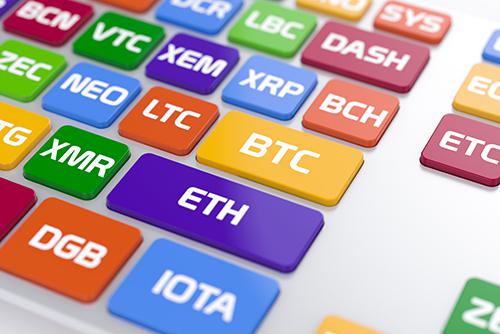What is an Altcoin?
An altcoin, or an alternative cryptocoin, is a cryptocurrency other than Bitcoin. Like Bitcoin, however, altcoins are powered by blockchain technology and are decentralized by nature.
Additionally, most altcoins are peer-to-peer, have mining protocols, and offer a unique way for parties to settle network transactions.
Some coins, like Bitcoin Cash, hard forked from Bitcoin in order to increase block size and transacting power.
Others implement a different mining protocol than Bitcoin in an attempt to consume less energy and prevent mining centralization.

What are the Different Types of Altcoins?
There are three different types of altcoins
Blockchain Powered Cryptocurrencies
Altcoins that are pure cryptocurrencies are used primarily for peer-to-peer transactions and have no specific use on a blockchain platform. They are used primarily as investable assets. Examples include Bitcoin Cash, Ripple, Dash, and Monero.
Blockchain Powered Infrastructures
These altcoins serve as the foundation or basic infrastructure from which developers create other applications or tokens. They are individual altcoins, but can be used as springboards for other projects. Examples include Ethereum, Neo, Nem, Waves, Omni, and Nxt.
Blockchain Powered Applications
These altcoins are tokens that serve specific utilitarian functions on a decentralized app or platform. They can be bought and sold on exchanges, but also unlock a blockchain platform’s key features. Examples include Eos, OmiseGO, Augur, Salt, Golem, and TenX.
How to Buy Altcoins
There are two ways to buy altcoins
1. Buy From Exchanges
The exchange functions as a digital marketplace that facilitates transactions with a wide variety of cryptocurrencies and fiat currencies.
The advantages of trading on exchanges include high liquidity and transparent pricing. Buy and sell order can be entered extremely easily, and as long as the user’s account is active and funded, they can trade as they please. They also have access to the vast universe of different cryptocurrencies.
Disadvantages include transaction fees and potential cyber security breaches. The average Bitcoin transaction fee, for example, spiked this year. Exchanges and miners charge fees in order to process trades and verify transactions.
What’s more, cryptocurrency exchanges aren’t known for being secure. It isn’t uncommon for exchanges to be hacked, with investors occasionally losing millions.
2. Buy Directly
Altcoins can also be bought directly in peer-to-peer transactions. Trading “over-the-counter” (OTC) can involve local trades, or direct trades whereby one user is paid with a fiat currency via a bank transfer. The seller then sends Bitcoins to the buyer’s wallet address. Several companies also list buy and sell offers, such as Bitcoin-OTC and BitQuick.
The main advantage of buying altcoins directly is the absence of exchange costs. When a user buys a coin for $100 per coin on an exchange, the $100 isn’t the net price, because fees haven’t been added in. In contrast, a coin bought for $100 direct actually costs $100.
The disadvantage is that buying direct is typically less transparent. Though OTC platforms try to protect traders, they can’t prevent mispricing and fraud from happening. Users who buy altcoins directly need to research the selling party carefully to make sure they aren’t being taken advantage of.
How to Invest in Altcoins?
Those that want to invest in altcoins should consider these crucial components.
Current Price and Market Cap
Investors can use the current price and market cap for an idea of how many coins they can buy with their dollars. For example, a low market cap may indicate potential growth in the future. Additionally, market cap impacts gain/loss calculations.
Big Picture Idea
Investors should consider the big picture goals and functions of a coin. They should avoid coins that they don’t believe have long-term viability.
Team and Advisory Board
Investors should invest in coins that have strong leadership behind them. The cryptocurrency world is fiercely competitive; only the best survive.
Existing Prototypes
Prototypes can give investors practical ways to test a coin’s function. It is a hands-on way for investors to test-drive their investment.
Real Life Use Cases
Investors should stay clear of coins that serve no practical purposes. A coin without any utilitarian value has no value at all.
Road Map
Road maps can inform investors of the coins development timeline and when future upgrades will take place. They should avoid coins without roadmaps or ones with roadmaps set too far in the future.
Investors and Sponsors
Investors should invest in coins with solid backing and a good reputation. To be sure, this doesn’t mean falling prey to the herd mentality, but it does mean following sound advice.
Historical Data
All major cryptocurrency exchanges contain historical data on each altcoin. This raw data can be used to calculate volatility and create projections about where trading volumes are headed.
